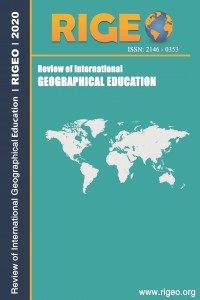Assessment of the Policy Guidelines for the Teaching and Learning of Geography at the Senior High School Level in Ghana
Assessment of the Policy Guidelines for the Teaching and Learning of Geography at the Senior High School Level in Ghana
This article empirically assessed the extent to which geography teachers adhered to the Ghana
Education Service policy guidelines on the teaching of geography at the Senior High School Level in
Ghana. Census survey was used to collect data from seven geography teachers because of the
researchers’ objective of gaining a quick insight into the problem at hand. Simple random sampling
was, however, used to select 80 geography students. Data were collected with the aid of two sets of
questionnaires which were personally administered by the researchers. Simple frequencies and
percentages were used in the analysis of the data collected. One of the key findings was that all the
teachers had knowledge and mastery of the content areas of geography. Again, the study revealed that
the geography teachers implemented to a fairly large extent the policy guidelines on teaching by
employing a variety of teaching methods, though with varying emphases. Another finding was that
some students could not acquire skills in the handling of certain equipment (e.g. in surveying) either
because of the non-availability of those equipment in their schools or their teachers lacked the expertise
to teach them how to use those equipment even though those equipment were available. The students
therefore suggested the frequent use of inquiry methods such as field work and project work. Based on
the findings, the study recommended that as part of the reforms in teacher preparation, there should be a
re-structuring of the geography education programmes in the universities so as to accommodate the
policy guidelines for teaching geography at the senior high school level. Lastly, the study also
recommended regular in-service training for practicing geography teachers to enable them hone their
professional competence, particularly their pedagogical skills.
Keywords:
Geography, policy guidelines, learning, inquiry, teaching senior high school, Ghana,
___
- Adjei A. A. (1992). The state of the art of teaching geography in secondary schools in Ghana. An unpublished PGCE Project Work, University of Cape Coast.
- Amadi, M. (2012). Teacher education in Nigeria. Lagos: Vitaman Educational Books.
- Asaber, P.K., Owusu, C., & Obeng, B. (2005). An examination of the influence of policy guidelines in SHS geography on classroom teaching & learning: A case study of the Cape Coast Municipality. An unpublished B.Ed. Social Science Project Work, University of Cape Coast.
- Byrme, C.J. (1983). Teacher knowledge and teacher effectiveness: A literature review of theoretical analysis and discussion of research strategy. Paper presented at meeting of the Northern Educational Research Association, Ellenville, New York.
- CRRD (1991). Ghana social studies series: Teachers’ manual book 5. Accra: Ministry of Education.
- CRRD (2010). Teaching syllabus for geography (2-4). Accra: Ministry of Education,Science and Sports.
- Curson, L.B. (1997). Teaching in further education. An outline of principles and practice (5th Ed), London: Continuum Education.
- Dale, E. (1969). Audio-visual methods in teaching (3rd Ed.), New York: Holt, Rhinehart &Winston.
- Darling-Hammond, L. (2000). Teacher quality and student achievement: A review of state policy evidence. Educational Policy Analysis,18 (1), 1-5.
- Department of Education (May, 2012). Teachers’ standards. Retrieved from www.education.gov.uk
- Doerr, A.H. (1990). Fundamentals of physical geography, Iowa, U.S.A.: Wm C. Brower Publishers.
- Gagne, R.M. (1967). Curriculum research and the promotion of learning. In R.E. (Ed.) Perspectives of curriculum evaluation. Chicago: Rand McNally.
- Harris, C. (1969). Teaching geography in Ghana. Accra: Ghana Publishing House.
- Kindsvatter, R., Wilen, W., & Ishler, M. (1992). Dynamics of effective teaching, New York: Longman.
- Knott, M.&Mutunga, P. (1993). Methods of teaching and learning. In B. Matiru, A. Mwangi, & R. Schlette (Eds.). Teach your best: A handbook for university lecturers (pp 157 -221). Kassel, Germany: University Press.
- Kochhar, K.S. (1984). The teaching of social studies. New Delhi: Sterling Publishers Private Ltd.
- Nacino-Brown, R., Oke, E.F., & Brown, P.D. (1982). Curriculum and instruction: An introduction to methods of teaching, London & Basingstoke: Macmillan Education Ltd.
- Preston, R & Herman, W.L. (1981). Teaching social studies in elementary schools (4th Ed.). New York: Rinehart & Winston Inc.
- Report on the President’s Committee on Review of Education Reforms in Ghana (2002). Meeting the challenges of education in the 21st century, Accra: Adwinsa Publications (Ghana) Ltd.
- Rulcher, T. (1991). Curriculum reforms. In A. Lewy (Ed.), The International Encyclopedia of Curriculum (pp 281 – 289). Oxford: Pergamon Press.
- Shulman, L.S. (1987). Knowledge and Teaching: Foundations of the new reform. Harvard Educational Review, 57(1), 1-22.
- Tamakloe, E.K., Amedahe, F.K., & Atta, E.T. (1996). Principles & methods of teaching. Accra: Black Mask.
- Tyagi, S. & Vasisth, K. (2012). Dimensions of teaching effectiveness. International Journal of Basic and Advanced Research, 1(2), 30 – 33. ISSN: 2278-714.
- Wardy, J. (2010). How college professors can teach and not just lecture. Retrieved on June 2, 2010 from www.helium.com
- Wheeler, D.K. (1967). Curriculum process. London: Hodder and Soughton.
- ISSN: 2146-0353
- Başlangıç: 2011
- Yayıncı: Eyüp ARTVİNLİ
